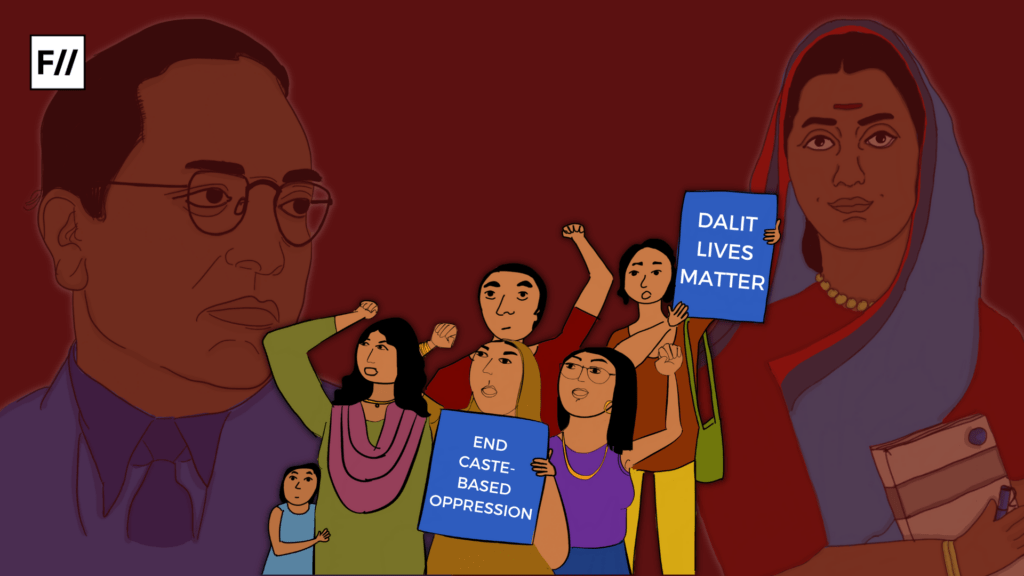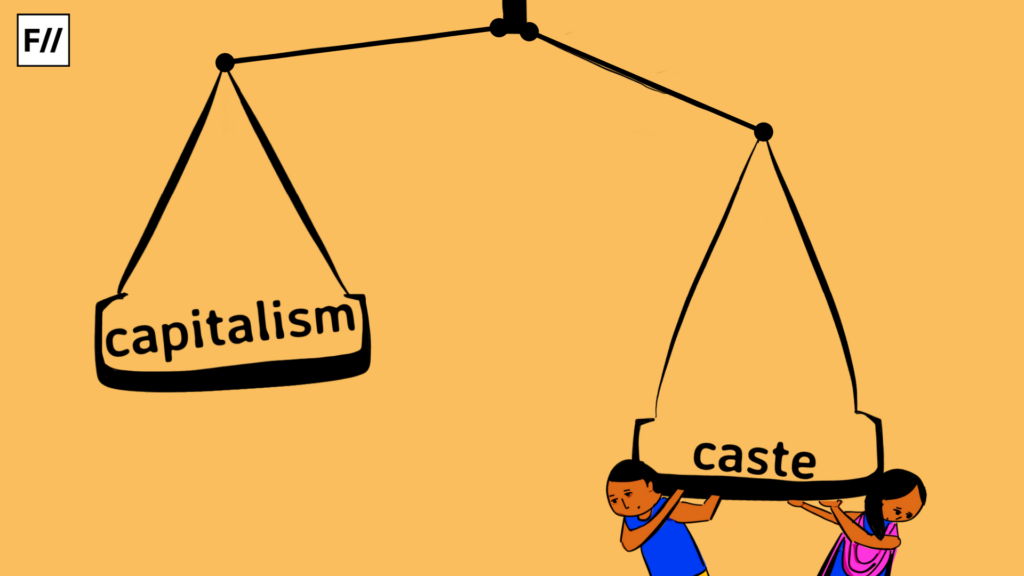Nilesh Dalsaniya, a 21-year-old Dalit man was allegedly beaten, abused, and forced to hold his ex-employer’s footwear in his mouth as an apology for demanding his salary. The incident occurred in Morbi, Gujarat. Vibhuti Patel a savarna woman, aka Raniba, owner of Raniba Industries is the main accused and has been charged with assault, criminal intimidation, rioting, and under relevant sections of the SC/ST (Prevention of Atrocities) Act as informed by the Deputy Superintendent of Police.
Vibhuti Patel had sacked Nilesh for no clear reason. When he insisted that his 16-day salary be paid, her brother and manager kicked, assaulted, and intimidated Nilesh. Vibhuti is also said to have slapped and dragged him to the terrace of the commercial complex. Nilesh is currently in a hospital receiving treatment for his injuries.
The question of the atrocities of the Dalit man and dethroning him is not just a question of gender but of caste, authority, and economics. The Girlboss feminism in its pursuit of liberating the woman and giving her authority has conveniently forgotten about the caste hegemony that is at work and subjugated the marginalised man.
This violent interaction of the patriarch and the Dalit man has sparked debates about Savarna feminism disregarding everything associated with feminism. While feminism is the propagation of the idea of equality, this incident states that hegemony travels beyond the gender construct. Feminism has for long spilt ink on the atrocities that women suffer, and rightly so, but it is now time to look beyond the cleavage of gender.
Patriacrchy and privilege in savarna feminism
Savarna Feminism is the feminist movement led primarily by upper-class and caste Hindu women. It conveniently neglects the role of caste in social dynamics and the bias it creates among gender lines too. Hegemonically, the privileges mimic the patriarch’s self-imposed superiority and marginalise any voice that doesn’t command a caste or class privilege.

Savarna Feminists approve of economic reservations and reservations for women but oppose caste-based reservations. They demand rights for women to step out of the kitchen and claim the public space but forget that the people who make it possible are the marginalised who are being suppressed further.
Caste system and poverty
Centuries of caste oppression and hegemony have ensured that the upper caste holds the maximum wealth and the marginalised are limited to access only crumbs. Savarna Feminism is just a feminine assertion of the same.
The Savarna Feminist or the Girlboss Feminist would employ an individual from a lowered caste or class to carry out menial domestic chores. These chores that she has long fought to absolve her from are conveniently handed to an ‘other‘ who is marginalised and oppressed.
The Savarna Feminist or the Girlboss Feminist would employ an individual from a lowered caste or class to carry out menial domestic chores. These chores that she has long fought to absolve her from are conveniently handed to an ‘other‘ who is marginalised and oppressed.
This ensures that the hegemonic construct of society doesn’t topple and the caste hierarchy remains intact. The consequence of caste is poverty which is also the cause of oppression. The vicious circle rotates and the Savarna Feminist makes sure that it remains so.
Prejudices of savarna feminist
Many Savarna discourses asserted that the Dalit woman is more liberated than the Savarna woman. Her freedom to access public space and contribute to the economics of her home makes her more emancipated than the rest. They claim that she has a voice that is loud and can interact with the patriarch in a demeanour that the Savarna Feminist can never.
This idea of liberation is biased and ignorant at the same time. Her labor is the result of poverty which is a consequence of her caste identity. She is doubly marginalised and caught in a dilemma that doesn’t let her emerge out of her forced identity. This prejudice is not limited to gender, the Dalit man and woman are caught in the stereotypes constructed by the Savarna Feminist.
Implicating savarna girlboss feminist
The term ‘Girlboss‘ earned a lot of social currency with attires and attitudes dedicated to it. It challenged the boundaries of femininity and introduced the image of a pantsuit-wearing emancipated woman. But under the cloak lay a woman trained under patriarchy’s able hands. She disregarded caste and class in her pursuit to make a mark in the man’s world.
She boasted of her economic empowerment while subjugating the marginalised to the vicious circle of poverty. She kept the structures of capitalism and patriarchy intact by ensuring that the only replacement was a woman replacing the man as patriarch.

This model of empowerment where the caste turns a blind eye ensures that the lowered caste suffers while the upper caste keeps accumulating wealth. Savarna women are adept at weaponising their femininity and empowerment to dictate the social fabric where their authority is expressed in the form of casteist humiliation and abuse.
Tokenism of savarna feminism
The cis White woman or the Savarna Feminist is adept at tokenising feminism. She selectively outrages against sexual violence, and is content with reservation for them but opposes caste reservation. She hires a house help while struts to work in the man’s world labelling herself ‘Girlboss.’
She conveniently forgets the plight of other women. She looks away from caste-based atrocities and even participates in strengthening prejudices that create a divide in society. She is the pallbearer of feminism who walks over the doubly marginalised to cradle patriarchy and strengthen capitalism.
Savarna feminism and capitalism
Caste and capitalism have coincidentally (or intentionally) always walked hand-in-hand. The economic status has almost always determined the social stature of a caste, and the agents of hegemony make sure that the status remains undeterred.

The Morbi case is not just a case of Dalit atrocity or Savarna feminism, it is also a reflection of the capitalist structure of society. When ‘Raniba‘ assumed the master-slave relationship and beckoned herself to be the master, Nilesh became the slave. He was no longer an employee and thus no rights were bestowed on him.
As an employee, he deserved an explanation for his firing from the job and remuneration for the days he had worked, but he was not given any. His continuous insistence on money was treated as insolence and he was met with a fate that a feudal lord would bestow. There was outrage, conversation, and a consequent nod to the rotten system.
Xenophobic feminists
Xenophobia refers to a fear or dislike of anything foreign or strange. Margins are carved out to filter the strange, the centres are filled with people considered normal. The strangeness is relegated to customs, clothing, food habits, and appearances. The xenophobic approach is a threat to feminism also because it endangers feminism with a nuance that all feminists are the same.

Neither all women nor all feminists are the same. Every ideology and subjective approach is different. Xenophobia is perpetuated through the construction of an ‘other‘ that doesn’t follow similar customs. It seeps deep into caste politics as the castes situated at different hierarchy levels appear strange. The lower the caste and class hegemonically, the stranger the person.
The act of forcing footwear in the mouth of an ex-employee who demanded his salary is a vulgar display of might. The superiority of caste, capitalist position, and stature of authority are to be blamed for the action. Savarna Feminism boasts of a woman in the position of power but ultimately enveils a patriarch replacing him to perpetrate casteism and capitalism brutally.





